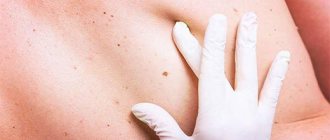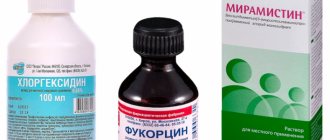Which moles need to be removed?
Removing moles on the face is a very important step, since this procedure will not only significantly change a person’s appearance, but can also preserve his health. In some cases, it is necessary to remove a mole. This is necessary when the nevus degenerates into a malignant tumor called melanoma. Signs of such degeneration are:
- spontaneous growth;
- rapid increase in size;
- change in shape and color;
- the appearance of pain, itching.
Mechanically damaged moles also need to be removed. It is better to remove those nevi that are located in places prone to skin trauma. This is especially common for formations that are subject to cuts during shaving in men or during various cosmetic procedures in women. This is due to the fact that any damage to a mole can lead to its degeneration into a malignant tumor.
Removing a mole on the face: is it possible or not?
Moles can occur in two types: medical and cosmetic. It depends on what type of mole it is, whether and how it can be removed. This decision can only be made by a specialist after a series of examinations.
When a mole is large, intrusive, and even more often damaged, it should be removed. Degeneration of a mole often leads to cancer.
If a mole has the following signs, it must be removed:
- education is growing and developing;
- the nevus began to change color, most often it becomes dark;
- the mole changes its size, growths and asymmetry appear;
- when the nevus is more than 5 millimeters in volume;
- redness and swelling appeared;
- the mole was damaged;
- blood oozes from the nevus.
Before undergoing the removal procedure, you should undergo an examination; some moles can be removed in a beauty salon, while others can only be removed under the supervision of an oncologist.
When choosing a removal method, you should pay attention to the following criteria.
Duration of the procedure. If anesthesia is not used during the procedure, not many will be able to withstand a long period in the doctor’s chair. Each person's pain threshold is different.- Rule out relapse. The procedure should remove the mole completely to prevent its reappearance.
- Healing process. The faster and more painlessly the wound heals after removal, the better. The removal method should not leave scars on the face.
Consultation with a specialist
Before removing any nevus, you should consult a qualified dermatologist. Only he will be able to conduct a proper examination, and if necessary, make a scraping (biopsy) of the formation and conduct a histological examination to determine its malignancy. Only after this will he be able to give specific recommendations on the most appropriate method for removing a particular mole.
This is due to the fact that if a nevus has degenerated into a malignant tumor, it must be excised only surgically. The consequences of removing a mole without prior consultation with a dermatologist can be very serious, since in the case of melanoma other methods of getting rid of such formations are ineffective.
Surgical removal of a mole on the face
Possible consequences
- The consequences that may arise after the mole removal procedure are different and will depend on many factors. First of all, this is the shape, the nature of the mole itself, the level of professionalism and compliance with all rules and regulations by the specialist. Do not forget about the individual reaction of the body.
- Removing moles using a laser is considered the safest; in most cases, the patient does not need time for rehabilitation after it. Moreover, there are few side effects after the procedure; this fact can explain the popularity of the method.
- After removal, minor swelling, redness and crusting may form, which disappear within 10 to 14 days.
- The only burdensome fact is post-operative care for the mole, which is an important component of the recovery period. The speed of recovery will depend on it.
Removal of moles on the face should be carried out exclusively in specialized clinics, by certified specialists. You should not save on your own health and beauty, because the consequences of poor-quality removal can be severe. First of all, pay attention to nevi that have changed visually. This may be a symptom of a serious illness developing.
Removal methods
Today, the following methods for removing common moles located on the face are the most widely used.
Laser mole removal
It is one of the most rational for removing nevi on the face. This method has a high level of antiseptic action, eliminating secondary infection.
The procedure is virtually painless and lasts only a few minutes. The skin heals quickly (in 10-14 days), so the likelihood of scar formation is minimized. The laser method allows you to remove even those nevi that are located in the most inaccessible places (on the eyelids, oral mucosa, in the interciliary space).
Radio wave removal
It is one of the most modern methods for removing these formations on the skin. It has an antiseptic effect, preventing the risk of secondary infection. The treated tissues heal very quickly. After the procedure, scars appear at the site of the mole extremely rarely.
Cryodestruction
The idea is to use liquid nitrogen, under the influence of low temperatures which destroys nevus cells. After this procedure, dead tissue remains on the wound and protects healthy skin cells from secondary infection. However, it is better not to use cryodestruction to remove nevi on the face, since the cold of liquid nitrogen negatively affects the skin. Also, in some cases, this procedure has to be repeated, which leads to the formation of quite noticeable scars.
Possible consequences of deletion
There are several ways to combat nevi. A complication of any technique can be infection of the wound if recommendations are not followed in the postoperative period, as well as the formation of a malignant focus if the mole is not completely removed by laser, nitrogen or electrical influence. Let's take a closer look at the possible consequences of each method:
- The laser is characterized by the complications already listed. Also, it is not used if there is an allergic reaction to laser radiation.
- When using cryodestruction, a repeat procedure is often required. In most cases, surrounding healthy tissues are affected, since it is not possible to clearly influence the neoplasm. There is also a risk of burns.
- After using electrocoagulation, a scar remains, which is not desirable on the skin of the face.
- Surgical techniques for manipulations on the face are practically not used, since scars subsequently remain. Typically, the surgical method is chosen when deep tissue excision is necessary, which requires general anesthesia.
Removal of flat moles
We recommend reading the article: Removing papillomas using traditional methods
Flat moles (lentigo) are sunny, youthful and senile. They appear for various reasons. As a rule, they are not recommended to be removed either with a laser or with radio waves. This is due to the fact that these nevi practically do not rise above the skin and after using such removal methods, depressions remain in their place.
The best way to remove flat moles from the skin of the face is photorejuvenation. This non-surgical, safe and painless method involves applying pulsed light to the upper and deeper layers of the skin. The rays penetrate the epidermis and stimulate the production of elastin and collagen, which improves physiological processes at the cellular level and noticeable rejuvenation of the skin. Thermal energy affects flat moles and eliminates problem cells. It promotes the synthesis of elements necessary for the skin. Light rays hitting lentigo affect melanin and eliminate pigmentation.
The duration of one procedure is 5-20 minutes. The course of therapy consists of 3-6 sessions. Before using this procedure, you should consult a dermatologist. During photorejuvenation, the skin is not damaged or infected. It is effective at any age and has a minimum of contraindications. Photorejuvenation cannot be performed during pregnancy, with a fresh tan or while taking photosensitizing medications.
In some cases, small flat moles are removed using special cosmetic procedures that are prescribed for freckles. They are aimed at lightening age spots.
Removing moles on the face with laser
Modern methods of getting rid of moles
There are many ways to get rid of moles on the face. The method is selected individually in each case. Moles have their own characteristics and depth. Regardless of the method chosen, the removed material must be sent for histological examination to confirm the occurrence of a benign process.
Laser removal
Laser removal of moles on the face is now one of the most widely used methods. The entire procedure will take about 10 minutes, and recovery will take about 2 weeks. In this case, no marks will remain on the skin. This method also allows you to get rid of a birthmark on your face. The procedure is carried out as follows:
- Local anesthesia is performed to ensure a painless procedure.
- The laser is adjusted individually in each specific case in order to completely remove the mole. The laser beam burns the nevus layer by layer, thereby achieving its complete destruction.
- After laser removal of a mole, a crust will remain on the face, which will come off on its own within a week.
After removing moles on the face in this way, you will need to follow simple rules:
- Do not visit the pool or sauna for two weeks.
- Do not go outside without sunscreen with a protection factor of at least 35, and do not sunbathe in a solarium.
- Avoid hypothermia and overheating.
- Do not use products containing alcohol for skin care after removing a mole.
Appearance of the skin after laser mole removal procedure. There is almost no scar left, and after some time it will become invisible.
Cryodestruction
In simple terms, this is freezing a mole with liquid nitrogen. The difference from the previous method is that the tissue is not removed, but remains as a protective film, under which the process of regeneration of healthy skin will occur. This method can get rid of a raised mole.
Disadvantages of the method:
- It is impossible to remove a mole on the face in one procedure, which requires repeating it.
- It is possible to get a burn to adjacent healthy tissues.
- This method cannot be used to remove moles on the face.
- If you receive a burn, a scar may form during healing.
- Compared to the laser method of mole removal, the healing time is increased.
Advantages:
- No scars after the procedure (provided there is no burn).
- Healing is painless.
- The temperature of liquid nitrogen is −180 degrees, ensuring complete disinfection.
After the cryodestruction procedure, a protective crust is formed, which prevents infection of healthy skin recovering after mole removal
Electrocoagulation
You can remove a mole on the face using electric current. This method also burns out the mole, just like when using a laser.
The advantages are:
- Complete removal of moles on the face in 1 procedure.
- The method is suitable for all types of moles and can be performed on all parts of the body.
- The procedure is completed quickly.
- Rarely does a scar remain.
Electrocoagulation is a reliable and fast way to get rid of moles
Recommendation. When removing moles with a laser or electrocoagulation, it is necessary to undergo an examination to confirm the good quality of the process, because there will be no material left for research.
Surgery
Removing a birthmark on the face, like moles, is impossible in this way due to the inevitable formation of scars. It should be said that this method is used for large, deep formations. It is performed in an operating room under general anesthesia. At the end of the operation, stitches will be placed, which must be removed after 5 days.
The method has all the risks of invasive intervention: the risk of bleeding and infection.
A thorough examination of the mole will answer questions about the need for removal.
Removal of raised moles
Removal of convex moles or large nevi is most often done using the following methods:
- Classic surgical excision with a scalpel. The doctor puts a special suture on the wound and treats it with an antiseptic. After 2-3 weeks, the scar on the skin becomes almost invisible.
- Using a laser method, in which the nevus is removed layer by layer until it is completely destroyed.
- Using electrocoagulation using high-frequency current. In this case, a nevus is cut off with a special tool that is heated by electric current. During the procedure, the blood vessels are sealed and the formation cells die. When removing moles using this method, local anesthesia is required. The mark from the formation will begin to heal within 3-4 days.
A special approach to removing nevi on the face
Under no circumstances should you choose a method for removing nevi on your face on your own. Moreover, they cannot be treated at home. The consequences of such self-medication often lead to disastrous results. Not only can a mole develop into malignant melanoma, but serious damage and infection without the intervention of a dermatologist can even result in death.
After removing the nevus, the place where it was should not be wetted for 2-3 days. Until the crust formed on the skin comes off on its own, it cannot be peeled off or lubricated with decorative and hygienic cosmetics. You can apply only those creams and ointments to the scabs that are prescribed by the specialist who performed the procedure for removing the formation. Since the face is constantly exposed, after mole removal you should avoid being in the sun or visiting a solarium. After the skin has healed, the area where the nevus was previously should be protected with creams with a high level of SPF.
Before deciding to take such an important step as removing a mole on the face, you should definitely consult with a dermatologist, and not make an independent choice of method and clinic. Such formations should not be joked with, since the wrong approach to their removal can lead to the development of malignant formations.
Safe moles
All nevi can be divided into two groups - dangerous and safe. Safe moles do not cause any harm to the body, but dangerous ones can eventually degenerate into a malignant formation. That's why it's important to learn to distinguish between them.
A safe nevus can be recognized by the following signs:
- its diameter is no more than 5 mm;
- the structure corresponds to the general texture of the skin;
- the edges are smooth, the boundaries are clear;
- hairs grow from a mole;
- A nevus is a pigmented spot - flat or convex, slightly raised above the surface of the skin.
Such birthmarks do not pose a threat to health. They can be removed if they look unsightly or are located in a place where they are easy to injure. Doctors recommend removing moles on the face, head, neck, armpit, palm, foot, genitals and other similar places.
The mole can be injured when it comes into contact with clothing, during shaving, combing hair, or bathing. Sometimes it is simply careless movement that leads to injury.
Some people are scared of red moles on the body. However, you should not be afraid of them if they meet all the signs described above. In this case, they do not pose any threat.










